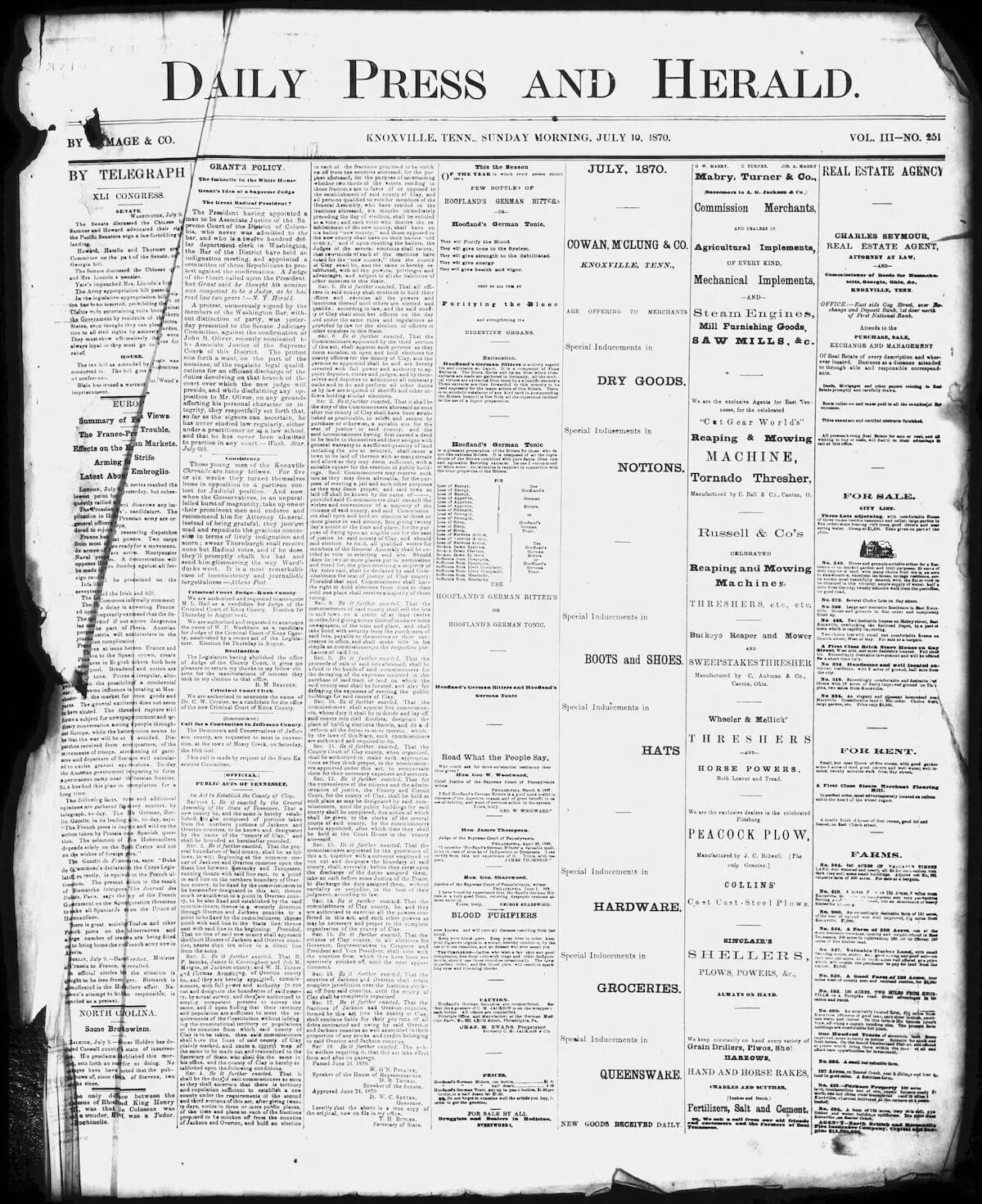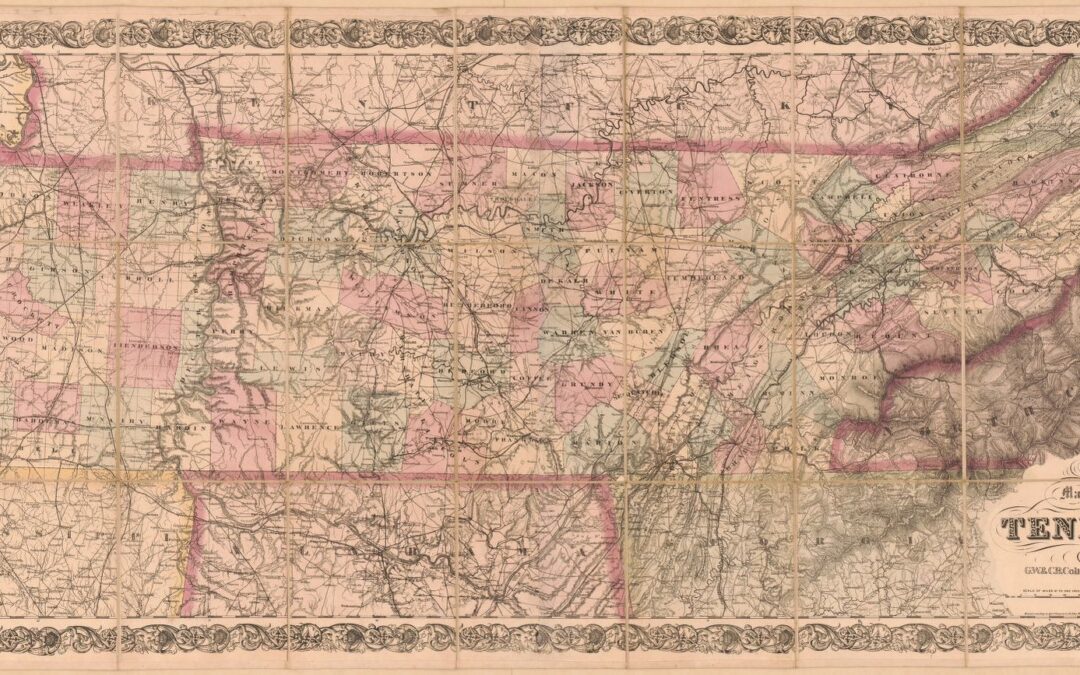The Arnell Law of 1865, a franchise bill, stripped all former Confederates of the right to vote. For Confederate soldiers, the disenfranchisement was to last five years. For Confederate leaders, it was to be a fifteen year wait. The plan also made the issuance of voter certificates a responsibility of the county court clerks. The aim of the plan, to keep former Confederates from voting, was not successful because the clerks tended to issue voter certificates liberally.
The results of the election that followed on August 5 reflected this reality when a majority of voters cast their ballots in favor of the conservatives. Even Samuel M. Arnell, after whom the bill is named, was defeated in his bid for Congress. To correct the failures of the Arnell Law, the legislature held special elections for the vacated offices.
The result of this election was the appointment of four Radicals and twenty-one conservatives. However, the conservatives were denied their seats. Barely mustering a quorum, the legislature then passed a revised franchise bill. The revised bill upheld many of the provisions of the Arnell Law but overhauled the registration process. The issuance of voter certificates was made the responsibility of “executive-appointed ‘Commissioners of Registration.’” The revised bill also revoked all of the previously issued voter certificates.
A number of events combined to successfully demolish the disenfranchisement of Tennessee conservatives. The Brownsville decision restored the right to vote to 30,000 ex-Confederates. Governor William G. Brownlow, a staunch Radical, resigned from the governorship in February 1869 to accept a seat in the U.S. Senate. He was succeeded by DeWitt C. Senter, a man “who cared more for re-election” than upholding the Radical agenda.
During his campaign, Senter “dramatically endorsed universal suffrage” and annulled the franchise law by replacing Brownlow’s commissioners with his own who then issued thousands of voter certificates to ex-Confederates. Senter was reelected to the governorship and the Conservative take-over of the general assembly. Tennessee legal historian Lewis Laska states that when the newly elected general assembly met on Oct. 4, 1869, “the Radical era was at an end.”
In his address to the legislature on October 12, Senter introduced the idea of having a constitutional convention. The House and the Senate followed suit by introducing bills calling for a convention. The House’s bill focused on addressing the “number and appointment of delegates.” The Senate’s bill called for a “limited convention” which would focus on only four issues: “suffrage, the judiciary, taxes, and the formation of new counties.” A compromise between the houses was reached on Nov. 15, 1869. The bill called for a vote to be held on Dec. 18, 1869 to allow the people to call for a convention to “amend, revise, or form and make a new constitution for the State.”
Constitutional Convention
Additionally, voters would choose 75 delegates to attend the convention. The results were 50,520 votes in favor of the convention with only 10, 020 votes against it. The convention was convened on Jan. 10, 1870, signifying the end of Radical Reconstruction in Tennessee.
The convention was held for three reasons. First, the franchise laws of the Brownlow legislature had to be removed from the constitution. Second, the convention sought to remove from office those who had been elected by the minority. Third, it symbolized a return to “majoritarian” rule and restored the public’s confidence in the state’s government. Under the intense scrutiny of the federal government, the delegates set about revising Tennessee’s constitution.
The typical convention delegate was “personified in William H. Williamson,” says Laska. Williamson was a lawyer from Lebanon who lost an arm for the Confederacy during the war and married the widow of John Hunt Morgan. Under the new constitution, he served as a circuit judge and later had a successful law practice after resigning the bench. Very few delegates were Radicals, and their influence during the convention was weak. The convention upheld much of the 1834 Constitution with great changes being made only on the issues of suffrage, the judiciary, the process of amending, and restricting the governor’s power.
New Counties
One of the major concerns for the convention delegates was the formation of new counties. George E. Seay, delegate for the counties of Smith, Sumner, and Macon, introduced a resolution to amend the constitution “so that new Counties may be established by the Legislature.” The proposed county had to be at least two hundred square miles and had to have a population of at least three hundred and fifty voters. Additionally, the resolution stipulated the following:
No line of such County shall approach the Court-house of any old County from which it may be taken nearer than eight miles, and no part of a County shall be taken to form such County or a part thereof, without a majority of the qualified voters in such part taken off shall consent. And where an old County may be reduced for the purpose of forming a new one, the area of said old County shall not be reduced to less than 350 square miles.
In response to the resolution, the convention formed a seven-man committee called the Committee on New Counties and County Lines to oversee the formation of new counties. George Seay served as chairman. All requests to form new counties, as well as all proposed amendments to the above resolution were required to be reviewed by the committee prior to the convention’s approval.
The Minority Report of the Committee on New Counties and County Lines stated they “cannot concur” with the requirement of the Constitution of 1834 for new county formation which said no county shall be less than 625 square miles. They noted this requirement was a result of the “sparse population of the then unsettled country,” and that the founders did not plan originally to “inconvenience the many for the benefit of the few.”
The committee believed the formation of new counties should serve the wants and needs of the people who should have “a convenient and accessible point of transaction of their legal, police and registration business.” The report further stated that if the requirements of the Constitution of 1834 were upheld by the convention, it would cause “annoyance and inconvenience…to a very large portion of the tax-payers of Tennessee.” They argued the creation of new counties should be seriously considered for the communities that are willing to fund and construct new courthouses and jails without aid from the counties they leave.
The report also laid out all the benefits of new county formation, stating “the State will lose nothing.” They argued the people would benefit the most as those who resided far from the county seats often traveled great distances at their own expense, sometimes “imperiling their lives by swimming swollen streams which they must cross under subpoena.” The people who were required to return for a day or consecutive days had the greatest disadvantage as they were “too far off to go home, and sometimes too poor to pay for good lodging if procurable.” Even if they were able to afford accommodations, often times there were not enough rooms for “the miserable throng of litigants, jurors and witnesses.”
The emancipation of slaves also played a part in the decision to allow new county formation as “every man” had become “his own servant to do his work.” The report argued that a person’s prolonged absence from his house for court purposes would greatly affect his family. Traveling to court “shall not be a journey of days” as the time had ended “when a gentleman can go to court in his carriage, leaving a host of servants to wait upon his household.”
Clay County Formed
The amendment proposed to create Clay County was introduced by Jackson County delegate Richard P. Brooks and read as follows:
That the Constitution be so amended that there may be a new county formed out of the Counties of Jackson and Overton. Provided, That in the formation it shall contain at least 400 qualified voters; and further, said new county shall contain at least 300 square miles of territory, and shall not reduce either of the old counties, from which it is taken, below 500 square miles. Provided further, That the line of said new county shall not approach either the old county seats nearer than 10 miles. Provided further, That a majority of qualified voters contained in said new county vote in favor of said new county. The county seat of the old counties, from which said new county is formed, shall not be moved without a concurrence of two-thirds vote of both Branches of the Legislature.
Clay is a Constitutional County officially organized on Dec. 17, 1870, the result of the 1870 Convention. The county was created to “relieve the difficulties” of those living in the Northern parts of Overton and Jackson Counties and having to travel to Livingston or Gainesboro for court.
The book History of Clay County, Tennessee, states, “When Clay County was created there were no roads. There were a few trails which were called roads. These were hard to travel over with anything other than horses and in many places the going was hard on horseback.”
The need for more roads was a prevalent topic in the Clay County Court minutes for the first two years, and they spent a lot of time discussing the creation of roads and the appointment of road overseers. The topography of the area proved to be a major obstacle for those more northern residents as they traveled to the county seats of Overton and Jackson.
An 1874 report by the Bureau of Agriculture described the Clay County landscape as follows:
It is best to imagine a plain…with a moderately undulating surface, nearly level to the west. Then imagine the middle of this plain cut diagonally across from north- east to south-west by a valley of irregular outline nearly 600 feet deep, and averaging a little more than one mile in breadth between the bases of the opposite hills. This is the valley of Cumberland River. Opening into it on the east side near the center of the county, is the long, winding valley of Obey’s River, with a general direction from east to west. A number of small creeks emptying into these two rivers, have valleys of their own, extending outward, and separated from each other by ridges or fingers of the plain to which the general surface of the county has been referred. These ridges and the intervals may be compared to the teeth of a saw, broad at the base and growing gradually narrower toward the apex.
The need for a network of roads was also reinforced by the fact that the Obey and Cumberland Rivers could only be used three and seven months of the year, respectively. These were the two main routes for the movement of goods to markets and for bringing in supplies from Nashville. When the rivers were too low to be navigable, the goods were “carried in wagons either from Nashville or from Glasgow, Kentucky.
Below is the Knoxville Daily Press and Herald newspaper of July 10, 1870, announcing the formation of Clay County.


